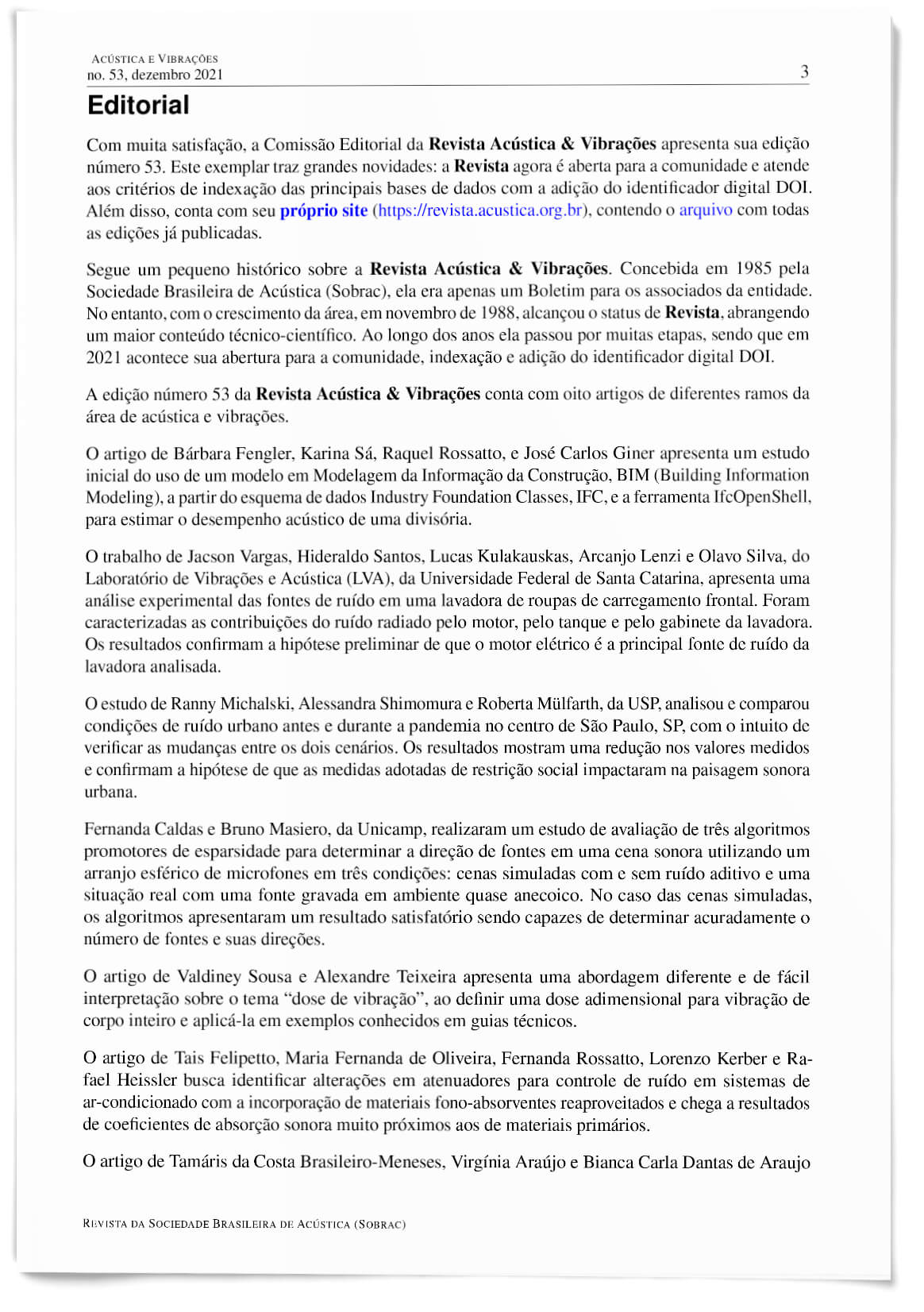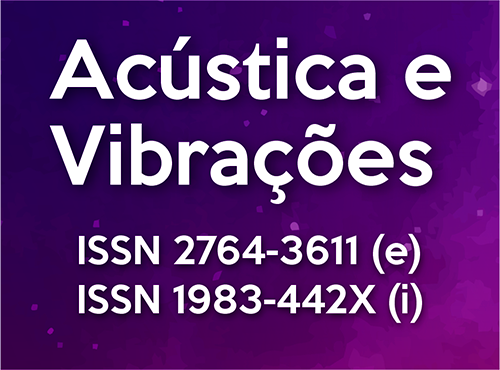Editorial Acústica e Vibrações 53
DOI:
https://doi.org/10.55753/aev.v36e53.140Keywords:
editorial, scientific divulgation, acoustics, vibrationsAbstract
Editorial in English
With a huge satisfaction, the Editorial Committee of Acoustic & Vibrations Journal (Revista Acústica & Vibrações) presents its 53rd edition. This issue brings great news: the Journal is now open to the community and meets the indexing criteria of the main databases with the addition of the DOI digital identifier. In addition, it has its own site (https://revista.acustica.org.br), which contains the archive with all editions already published.
Here’s a little history about Acoustic & Vibrations Journal. Conceived in 1985 by the Brazilian Acoustic Society (Sobrac), it was just a Bulletin for the entity’s associates. However, with the growth of the area, in November 1988, it reached the status of Journal, covering a greater technical-scientific content. Over the years it has gone through many stages, and in 2021 it opens to the community, indexes and adds the DOI digital identifier.
Issue number 53 of Acoustic & Vibrations Journal has seven articles from different branches of the acoustics and vibrations area.
The article by Bárbara Fengler, Karina Sá, Raquel Rossatto, and José Carlos Giner presents an initial study using a model in Building Information Modeling (BIM) from the Industry Foundation Classes (IFC) data schema, and the IfcOpenShell tool, to estimate the acoustic performance of a partition.
The work from Jacson Vargas, Hideraldo Santos, Lucas Kulakauskas, Arcanjo Lenzi and Olavo Silva, from the Laboratory of Vibrations and Acoustics (LVA), at the Federal University of Santa Catarina, presents an experimental analysis of noise sources in a front-loading washing machine. The contributions of the noise radiated by the engine, the tank and the washing machine cabinet were characterized. The results confirm the preliminary hypothesis that the electric motor is the main source of noise in the analyzed washing machine.
The study by Ranny Michalski, Alessandra Shimomura and Roberta Mülfarth, from USP, analyzed and compared urban noise conditions before and during the pandemic in downtown São Paulo, SP, in order to verify the changes between the two scenarios. The results show a reduction in the measured values and confirm the hypothesis that the adopted measures of social restriction had an impact on the urban soundscape.
Fernanda Caldas and Bruno Masiero, from Unicamp, carried out an evaluation study of three sparsity promoting algorithms to determine the direction of sources in a sound scene using a spherical array of microphones in three conditions: simulated scenes with and without additive noise and a real situation with a source recorded in an almost anechoic environment. In the case of simulated scenes, the algorithms showed a satisfactory result, being able to accurately determine the number of sources and their directions.
The article by Valdiney Sousa and Alexandre Teixeira presents a different and easier interpretation on the topic “vibration dose”, by defining a dimensionless dose for whole-body vibration and applying it in known examples in technical guides.
The article by Tais Felipetto, Maria Fernanda de Oliveira, Fernanda Rossatto, Lorenzo Kerber and Rafael Heissler seeks to identify changes in attenuators for noise control in air conditioning systems with the incorporation of reused sound-absorbing materials and arrives at results of sound absorption coefficients very close to those of primary materials.
The article by Tamáris da Costa Brasileiro-Meneses, Virgínia Araújo and Bianca Carla Dantas de Araujo presents a compilation of parameters used for environmental noise assessment in standards and environmental laws of South American countries. From the research, it was concluded that, in general, countries define the permitted sound levels based on urban zoning and the division between night and day periods, with Paraguay being the only country that presented specific values for peak hours.
Closing the scientific articles section, the article by Viviane Melo, Roberto Tenenbaum, Edna Sofia Santos, Murilo Soares and Gabriel Sampaio, from UFSM, presents a validation study of the results from RAIOS 7 computer code for numerical simulation of room acoustics with auralization. The calculation of acoustic parameters and impulse responses both monaural and binaural are validated.
Issue 53 also has nineteen inserts, presented in the Calls and News & Reviews sections. Details are presented on: the activities of INAD 2021, the closing of the International Year of Sound 2020 & 2021, the reviews of five books in the field of acoustics and vibrations (in english and portuguese), the mutual cooperation agreement signed between Sobrac and the Portuguese Society of Acoustics (SPA), the critical listening room under construction at Unicamp, the Young Acousticians Network (YAN), Sobrac’s electoral process for 2021–2022, the International Festival of Music at Home (Fimuca Áudio), the online Workshop: Acoustic urban planning in cultural zones, the 1st Virtual Colloquium “Cuscuz com Acústica”, and the 2nd Academic Month of the Acoustical Engineering (UFSM).
The News & Reviews section also has a short article about a new application for the Brüel & Kjær sound level meter, model 2245, called Product Noise Partner that makes measuring sound power much easier. Another very interesting article in the section is about room acoustics simulations developed at Brazilian universities. Following, informations concerning the Acoustical Engineering program, winner of the five stars given by Estadão News’ College Guide. Finally, there is a list with upcoming events in acoustics throughout Brazil and the world.
We also have calls in this issue: how to publish articles in the journal; how to join Sobrac; and information about FIA 2020/2022 and about the VII Southern Seminar on Acoustics and Vibrations (Segav).
We would also like to take the opportunity to invite the reader to the 12th Ibero-American Acoustics Congress (FIA) together with the XXIX SOBRAC Meeting, which will be held in Florianópolis, from August 28 to 31, 2022, rescheduled again due to the pandemic. The program will include lectures by world-renowned experts, as well as presentations of papers and posters on topics related to the areas of Acoustics and Vibrations. A technical exhibition with the latest advances in products and equipment will take place in parallel with the Congress. We also invite you to the VII Southern Seminar on Acoustics and Vibrations, held in person in São Leopoldo, RS, on September 23, 2022.
We would like to thank Sobrac, the authors and the group of reviewers for their contribution to this edition (which breaks a page record, being the largest ever published).
Enjoy reading!
Cordially,
Editors A&V n◦ 53, December 2021

Downloads
Published
How to Cite
Issue
Section
License
Copyright (c) 2021 Acústica e Vibrações

This work is licensed under a Creative Commons Attribution-NonCommercial-ShareAlike 4.0 International License.




